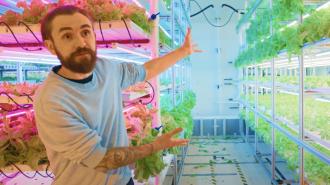When Clayton Mooney and Danen Pool founded the indoor farming company Nebullam in 2017, they knew that growing crops indoors would be the future of farming. At the time, however, indoor farming technology was far from futuristic.
“We saw that indoor farming was very antiquated, where you have a bunch of growing equipment that’s all stacked on top of each other,” Mooney told Freethink. “It doesn’t move, so you have to have these big aisleways. And then there’s little to no software in the day-to-day, amounting to producing small amounts of food per square foot.”
It’s no surprise that indoor farming has yet to take off in full force. Barely more than two decades old, indoor farming was first conceived in 1999 by Dickson Despommier, a professor at Columbia University, who with his students drafted an ambitious design of a “skyscraper farm” that could feed 50,000 people.
Today, indoor farms resemble warehouses more than skyscrapers. But companies like Nebullam are working hard to build the next generation of indoor farms. They aim to make the industry more efficient in order to take advantage of indoor farming’s inherent benefits.
Moving farms indoors
The main advantage of indoor farming is eliminating natural restrictions. Unlike traditional farming, the method allows farmers to grow produce year-round without having to worry about unpredictable weather, wasting water, or exposing crops to insects, herbicides, and pesticides. Stacking plants on top of each other also maximizes the utility of the space, allowing farmers to pack as much as 700 acres of farmland into the size of a big-box retail store.
Versatility is another major draw. The fact that indoor farms can grow crops in otherwise barren areas is one reason agricultural experts predict that the industry will help feed the world’s growing population, which is projected to hit 9.3 billion by 2050. In order to meet demand, the world will need to increase food production by 60% by that year, according to the United Nations’ Food and Agriculture Organization.
But indoor farming isn’t only about quantity.
As the demand for organic foods continues to grow, indoor-farmed produce seems to be increasingly appealing to health-conscious consumers who are wary of the chemicals used in commercial farming. (To be sure, there’s an ongoing debate over whether indoor-farmed foods should be classified as organic.)
Freshness is another quality-related appeal. Unlike conventional produce, which can take several days to reach the grocery store, indoor-farmed food can be harvested and delivered to the grocery store within hours, provided that the farm is located close to the store. Because produce begins to lose nutrients as soon as it’s harvested, less time in transit means healthier food.
But while indoor-farmed produce may be more nutritious than its conventionally produced counterpart, it’s generally more expensive. The chief cost is lighting. After all, giving up the free resource of sunlight means indoor farms require a lot of electricity to power the LED lights that give life to plants. In some farms, lighting costs can account for 30% of the company’s total operating costs.
What’s more, not all indoor farms collect data on the efficiency of their lighting and climate-control systems, while others utilize equipment that hasn’t changed much over the past two decades. Facing steep costs and outdated technology, many indoor farms take seven years just to turn a profit.
Building the future of farming
With these shortcomings in mind, Nebullam set out to optimize the future of farming. The company’s initial goal was to develop and sell technology to up-and-coming indoor farming companies. That included software that helps analyze and optimize the production process, and equipment that’s more mobile so farmers can position crops where indoor conditions are ideal.
“We thought we could come along and implement better, more scalable technology to help indoor farms become profitable faster,” Mooney told Freethink.
But first, Nebullam had to prove that its concept worked.
Using its own software and equipment, the company began growing produce — mainly lettuce and microgreens — and selling it to local restaurants and grocery stores near its facility in Ames, Iowa. The company soon started seeing revenues increase.
Then came the pandemic. Facing dwindling revenues as a result of restaurant closures, Nebullam had to pivot in order to find new buyers for its produce. So the company decided to implement a subscription model where customers order produce online and have it delivered to their homes on a recurring basis — all within hours of harvesting.
Overhauling the business model wasn’t easy at first. But Mooney and his team started with simple goals: build a website and have everyone at the company find 12 new customers whom they didn’t already know. By the end of 2020, Nebullam had gained 50 subscribers.
The company then analyzed demographic data on that existing customer base to figure out how to best acquire new customers. This high-tech approach ultimately led Nebullam to double down on an analog strategy: branded door stickers.
“It’s costing us three times more to pick up a subscriber online — and that’s about $150 — compared to picking up a subscriber through door stickers for about $50,” Mooney told Freethink. “We always want to be reducing that, so now we’re making more and more data-driven decisions around customer acquisition costs.”
Minimizing the costs of growing produce and acquiring new customers could enable Nebullam to scale at a quick pace. Nebullam currently has about 300 subscribers and one growing facility with 1,000 square feet of production space. By the end of 2022, the company aims to open a new location and increase its customer base to 1,500.
More broadly, the global indoor farming market is expanding rapidly. One 2022 industry report projected that the market will quintuple within the decade, growing from $4.1 billion in 2021 to $31.1 billion by 2030. With LED lights becoming cheaper and companies like Nebullam using data-driven strategies to optimize production, the future of farming may be coming sooner than previously thought.
“We think everyone deserves access to reliable local food year-round,” Mooney said. “Our vision is to replace the produce aisle.”






